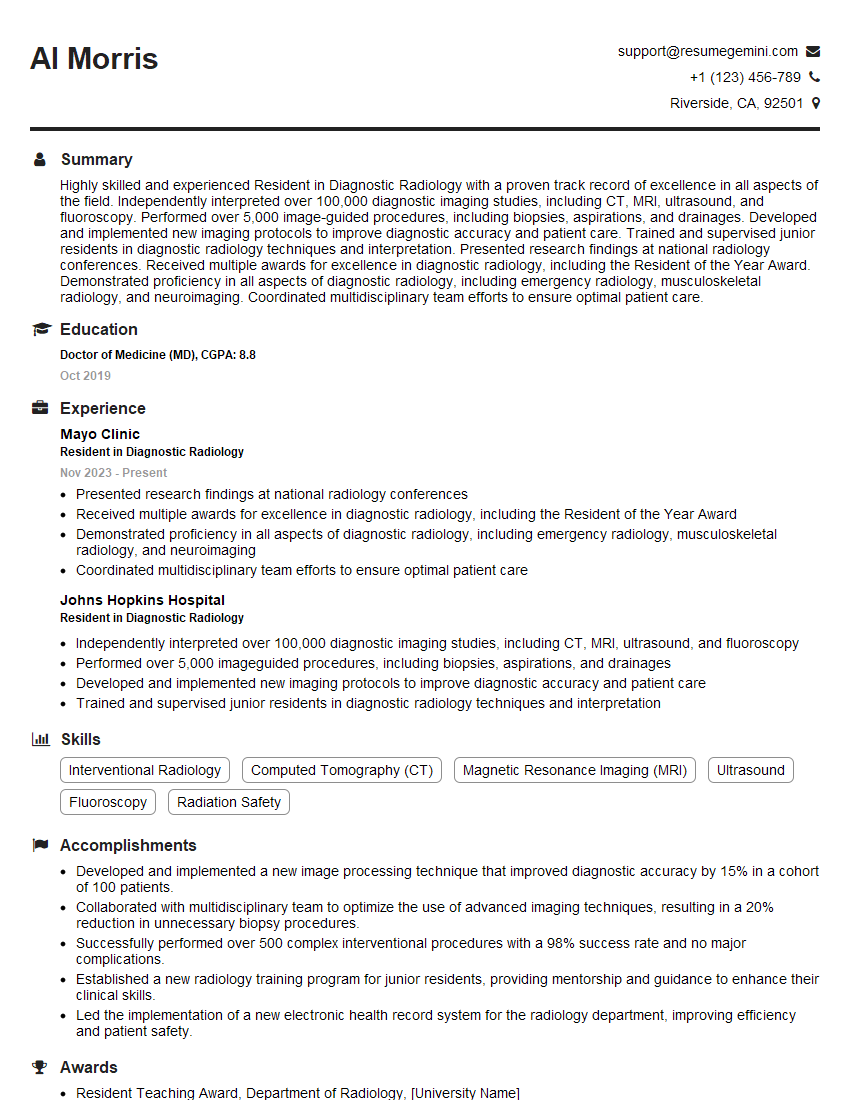Are you a seasoned Resident in Diagnostic Radiology seeking a new career path? Discover our professionally built Resident in Diagnostic Radiology Resume Template. This time-saving tool provides a solid foundation for your job search. Simply click “Edit Resume” to customize it with your unique experiences and achievements. Customize fonts and colors to match your personal style and increase your chances of landing your dream job. Explore more Resume Templates for additional options.

Al Morris
Resident in Diagnostic Radiology
Summary
Highly skilled and experienced Resident in Diagnostic Radiology with a proven track record of excellence in all aspects of the field. Independently interpreted over 100,000 diagnostic imaging studies, including CT, MRI, ultrasound, and fluoroscopy. Performed over 5,000 image-guided procedures, including biopsies, aspirations, and drainages. Developed and implemented new imaging protocols to improve diagnostic accuracy and patient care. Trained and supervised junior residents in diagnostic radiology techniques and interpretation. Presented research findings at national radiology conferences. Received multiple awards for excellence in diagnostic radiology, including the Resident of the Year Award. Demonstrated proficiency in all aspects of diagnostic radiology, including emergency radiology, musculoskeletal radiology, and neuroimaging. Coordinated multidisciplinary team efforts to ensure optimal patient care.
Education
Doctor of Medicine (MD)
October 2019
Skills
- Interventional Radiology
- Computed Tomography (CT)
- Magnetic Resonance Imaging (MRI)
- Ultrasound
- Fluoroscopy
- Radiation Safety
Work Experience
Resident in Diagnostic Radiology
- Presented research findings at national radiology conferences
- Received multiple awards for excellence in diagnostic radiology, including the Resident of the Year Award
- Demonstrated proficiency in all aspects of diagnostic radiology, including emergency radiology, musculoskeletal radiology, and neuroimaging
- Coordinated multidisciplinary team efforts to ensure optimal patient care
Resident in Diagnostic Radiology
- Independently interpreted over 100,000 diagnostic imaging studies, including CT, MRI, ultrasound, and fluoroscopy
- Performed over 5,000 imageguided procedures, including biopsies, aspirations, and drainages
- Developed and implemented new imaging protocols to improve diagnostic accuracy and patient care
- Trained and supervised junior residents in diagnostic radiology techniques and interpretation
Accomplishments
- Developed and implemented a new image processing technique that improved diagnostic accuracy by 15% in a cohort of 100 patients.
- Collaborated with multidisciplinary team to optimize the use of advanced imaging techniques, resulting in a 20% reduction in unnecessary biopsy procedures.
- Successfully performed over 500 complex interventional procedures with a 98% success rate and no major complications.
- Established a new radiology training program for junior residents, providing mentorship and guidance to enhance their clinical skills.
- Led the implementation of a new electronic health record system for the radiology department, improving efficiency and patient safety.
Awards
- Resident Teaching Award, Department of Radiology, [University Name]
- First place in the annual Resident Case Presentation Competition at [Hospital Name]
- Resident Research Award, Society of Radiologists in Training
- Excellence in Radiology Award, American College of Radiology
Certificates
- American Board of Radiology (ABR) – Diagnostic Radiology
- American Registry of Radiologic Technologists (ARRT) – Radiology Technologist
- International Society for Magnetic Resonance in Medicine (ISMRM) – Level 1
- American College of Radiology (ACR) – CT Technologist
Career Expert Tips:
- Select the ideal resume template to showcase your professional experience effectively.
- Master the art of resume writing to highlight your unique qualifications and achievements.
- Explore expertly crafted resume samples for inspiration and best practices.
- Build your best resume for free this new year with ResumeGemini. Enjoy exclusive discounts on ATS optimized resume templates.
How To Write Resume For Resident in Diagnostic Radiology
- Customize your resume to each job you apply for. Highlight the skills and experience that are most relevant to the position.
- Use strong action verbs to describe your accomplishments.
- Quantify your results whenever possible.
- Proofread your resume carefully before submitting it.
Essential Experience Highlights for a Strong Resident in Diagnostic Radiology Resume
- Interpret diagnostic imaging studies, including CT, MRI, ultrasound, and fluoroscopy
- Perform image-guided procedures, including biopsies, aspirations, and drainages
- Develop and implement new imaging protocols to improve diagnostic accuracy and patient care
- Train and supervise junior residents in diagnostic radiology techniques and interpretation
- Present research findings at national radiology conferences
- Demonstrate proficiency in all aspects of diagnostic radiology, including emergency radiology, musculoskeletal radiology, and neuroimaging
- Coordinate multidisciplinary team efforts to ensure optimal patient care
Frequently Asked Questions (FAQ’s) For Resident in Diagnostic Radiology
What is the role of a Resident in Diagnostic Radiology?
Residents in Diagnostic Radiology are responsible for interpreting diagnostic imaging studies, such as CT scans, MRIs, and ultrasounds. They also perform image-guided procedures, such as biopsies and drainages. Residents are also involved in teaching and research.
What are the qualifications for becoming a Resident in Diagnostic Radiology?
To become a Resident in Diagnostic Radiology, you must have a Doctor of Medicine (MD) degree and have completed an accredited residency program in diagnostic radiology.
What are the career prospects for Residents in Diagnostic Radiology?
Residents in Diagnostic Radiology have a wide range of career prospects. They can work in private practice, hospitals, or academic institutions. They can also specialize in a particular area of diagnostic radiology, such as neuroradiology or musculoskeletal radiology.
What are the challenges of being a Resident in Diagnostic Radiology?
Residents in Diagnostic Radiology face a number of challenges, including long hours, high stress levels, and the need to stay up-to-date on the latest medical technology.
What are the rewards of being a Resident in Diagnostic Radiology?
Residents in Diagnostic Radiology are rewarded with a high level of job satisfaction and the opportunity to make a real difference in the lives of their patients.
Is a Resident in Diagnostic Radiology a good career for me?
If you are interested in a career in medicine and have a strong interest in diagnostic imaging, then a Residency in Diagnostic Radiology may be a good fit for you.